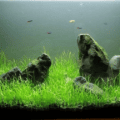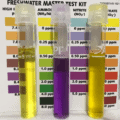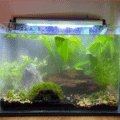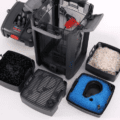When I was initially looking into the filtration system I use for my fish tank I wasn’t aware of the many varieties out there.

My initial search into this subject led to the question of what is a canister filter for an aquarium?
There’s a lot of information out there and many tout canister filters as the best available.
I do agree with this statement now, but it just seems there’s a lack of real information available for the purchaser outside of item descriptions and business copy.
Many didn’t even let me know how a canister filter works, much less the difference between any of the other external systems.
Well, I’m here to fix this issue, so let’s get started.
What exactly is a Canister Filter?
Aquarium filters serve the purpose of removing detritus, chemicals, and other toxic particles from the water, including providing a bed for biological filtration. There are quite a few systems out there that look different from each other, so an initial foray into these can seem quite confusing.
A canister filter can be defined as:
A canister filter is an external chamber that pushes aquarium water through various filter media using a rotor. After the water gets filtered in the media, it gets returned to the tank through an outlet.
The main chamber is a somewhat cylindrical device that contains a filter medium and a pump.
It sits outside of the aquarium but is connected to it by two hoses – an intake and a return.
Power is actually not needed for water to flow there, as the hoses act as a siphon.
However, in this type of aquarium filter a pump needs to force the water through the filtration medium.
The size of the chamber varies depending on the size of the tank it’s operating on and is usually located fairly close to the aquarium.
Larger versions of this filtration system were initially used for filtering drinking water for humans.
How do Canister Filters Function?
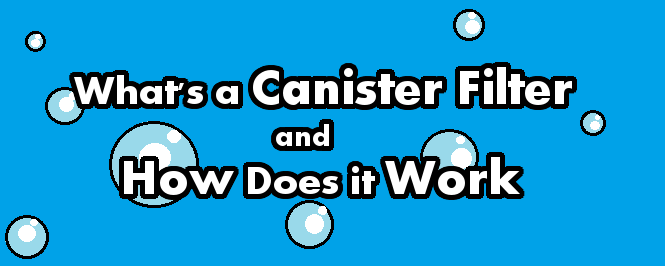
Upon seeing this device one might be confused as to how it possibly filtrates water when it’s outside of the aquarium.
Here’s how canister filters work:
Filter canisters operate on the principle of siphoning water from the aquarium through an intake and a return.
Siphoning is the process of creating a line of no interruptions between two bodies of water.
With this water can flow freely, quickly, and in any vertical position without the need for pumps.
Once the water enters into the intake of the main chamber it is forced via a pump that pressures water to the other side of the chamber through the filtration medium.
The liquid is then siphoned back through the return into the tank.
In most canister filters, the direction of the flow is from the bottom to the top, but there are plenty of top-to-bottom, back-to-front, and center-out canister filters.
This variety of options gives you the freedom to customize the water flow depending on the needs of your fish.
The medium of filtration can be modified as well with various resins and filter types to suit the needs of the aquarium it is servicing.
The canister filter may seem more disconnected than other filters on first glance, however, it is anything but.
How do canister units compare to other aquarium filtration methods?
The canister filter is not only a fairly interesting and adaptable way of keeping a tank clean.
It also stacks up exceedingly well compared to other means of filtration:
Many of the benefits of the canister filter stem from the simple fact that it doesn’t take up any space in the aquarium.
A much larger filtration area than usual can be utilized in this way, making clogs much less likely.
Maintenance, such as cleaning, can easily be done without causing distress on the inhabitants of the tank.
It also allows for inline customization through external plumbing such as water heaters and diffusers.
This is compared to other filtration systems that take up space inside the tank at least.
The HOB filter functions by sitting on the back of the tank and sucking up water via a powered impeller that pushes water through its filtration medium and then falls back down into the tank.
This can be very noisy and even deafening to any fish swimming within the aquarium, unlike the quiet siphoning of a canister one.
HOB filters also do not offer any sort of the plumbing customization that the canister filters do.
This can be an immediate deal breaker for a safe aquarium depending on the environment the tank is kept in.
The larger surface area also provides a much less disturbing cleaning experience and less maintenance in general as it doesn’t have to be cleaned as often.
Another benefit canister filters bring to the table is the ability to position their intake and return anywhere in the aquarium.
This allows you to increase oxygenation by creating a back-to-back water flow throughout the entire tank.
Which can come especially handy when you’re caring for fish with high oxygen demands like hillstream loaches.
It is just simply a better filter compared to the HOB varieties.
Should you get one?
It should definitely be a consideration at this point if you value the overall health and longevity of the environment of the tank.
HOB filters are not designed for that amount of fish in smaller volumes of water whereas with a canister one employed the filtration will be able to handle the bioload.
Turtle tanks as well can reap benefits from a canister-type filtration system as they tend to gunk up an aquarium very quickly if the filter is sub-par.
The stillness of the siphon suits them nicely too, as turtles do not like the loud splashing sounds of HOB filters.
The future owners of larger tanks, even with simpler varieties of fish in them, need to consider these filters as well.
That larger filter medium means a larger amount of water gets filtered where HOB filters seem unable to keep up much of the time in these environments where canister filters have noticeably fewer issues.
Canister filtration units are the best choice if you want to do everything in your power to maintain good health and life quality for your aquatic friends.
How to choose the best one for your fish or turtle aquarium?
This can definitely be a tough question for the inexperienced fishkeeper.
Its answer will depend on the size of the tank you are running and the pets you’re going to keep in it.
They’re a great place to start since they’re affordable and will give you a good idea of what to look for further on.
I’ve also written a guide on choosing the best filter for fish tanks here. There I made sure to give specific recommendations based on livestock and tank size while taking into account the particular pros and cons of each model that I’ve reviewed.
It took me 4 whole days of hard work to put it together, thus I’m confident that it will save you an hour or ten of research if you’re an entry-level aquarist.
However, if you plan on keeping turtles things become slightly different. I had to write another separate guide because these animals’ filtration requirements were not the same as with aquarium fish.
Turtles are messier and need stronger water turnover combined with more filter media. If you want to go deeper check out the guide on turtle filters I linked to just a few sentences earlier.
Check out whichever suits your needs before purchasing so you can make an informed decision.
Don’t waste time and cash on inadequate filtration…
Are there known issues with these types of filters?
Aside from tube leaks in the external plumbing, which shouldn’t be a problem unless damaged, the biggest issue I’ve run into with canister filters is that of the initial priming. Priming is the initial process of filling the filter, and pump therein, with water.
This can be a bit loud and troublesome, at least for me when I got my first tank, but it’s a normal process and fades over the course of the first few days once the filter is up and running properly.
Though hobbyists have universally agreed that the canister units are hands down the quietest form of effective aquarium filtration, some models are definitely quieter than others.
How often should you clean a canister filter?
Even though canister filters can hold way more filter media than HOBs, they still need to be cleaned.
Leaving them out of your maintenance schedule for too long will eventually lead to weaker flow, cloudy water and a buildup of organic waste. Since these conditions can impair the health of your aquatic pets, you’ll have to clean your canister filter on a regular basis.
Generally speaking, canister filters should be cleaned at least once a month. In case you’re looking after messy pets, then you should service them every two to three weeks. Some fishkeepers advocate for a “wait-until-it’s-dirty” approach when it comes to canister filter maintenance.
I personally don’t like this method since it promotes sloppiness.
In many cases, you’ll see an increase in nitrates before coming around to clean your filter.
Safe to say, this isn’t doing your pet fish any favors.
My Final Thoughts
Hopefully, this has cleared up any questions you may have.
External filtration cartridges are by far the best option for pretty much any aquarium setup and they really aren’t as complex as they look. So what’s the point of a canister filter over other types?
They work and they work well is my answer.
Quality of life for fish and other aquatic residents is my primary concern when I see people using noisy and inefficient filters for their already overstocked tanks.
It’s just like if your AC unit shook your whole house and potentially made it hard to breathe if you had too many friends over.

